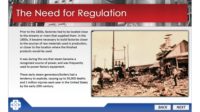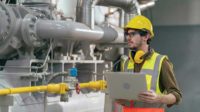The National Board of Boiler and Pressure Vessel Inspectors was founded in 1919 and has been dedicated to promoting safety in the industry. In addition to numerous other activities, the organization publishes the National Board Inspection Code (NBIC). This guidance was first published in 1946 as a guide for chief inspectors. It has since become an internationally recognized standard, adopted by most U.S. and Canadian jurisdictions. The NBIC provides standards in four sections: (1) installation, (2) inspection, (3) repair and/or alteration, and (4) pressure relief devices. The code is revised every two years, and the 2021 version was released in July.
The following is a summary of key changes to the NBIC code.
PART 1 — Installation requirements and guidance for pressure-retaining items.
a) “General Requirements for Boilers, Potable Water Heaters and Pressure Vessels.”
• Added requirement for CO monitor/alarm when required by authority having jurisdiction (1.6.9)
• Revisions made to add additional details/specifications for testing and final acceptance (1.6.10).
b) “Pressure Relief Valves – General” new requirements were added to remove covers, caps, plugs, wires, or restraining devices used for shipping/transporting pressure relief valves prior to a valve’s installation for both power boilers and heating boilers (2.9.1 g, 2.9.1 h, 3.9.1 a, and 3.9.1 b).
c) “Modular Steam Heating and Hot Water Heating Boilers” revised maximum ratings (3.7.8.1).
d) “Pressure Relief Valve Discharge Piping” added new rating requirements (3.9.1.5 c, d, and e).
e) “Liquid Carbon Dioxide Storage Vessels” have revised carbon dioxide gas detection system requirements (S3.4).
f) “Thermal Process Heaters” have updated overpressure protection requirements (S5.7).
g) Supplement 8 generated for “Installation of Pressure Vessels for Human Occupancy.”
h) Supplement 9 generated for “High-Temperature Water Boilers.”
The CO issue has been difficult for this group, with strong opinions on both sides. While CO is a serious issue, it is a not strictly a pressure vessel issue and not easily resolved. Texas has required CO monitoring in boiler rooms, and we may see more of this local action.
PART 2 — Information and guidance needed to perform and document inspections.
a) New requirements for remote visual inspection for “Personal Safety Requirements For Entering Confined Spaces” (1.4.1 c and 4.2.1 c).
b) Several revisions/updates to the inspection requirements for “Pressure Vessels For Human Occupancy” (2.3.6.8).
c) New inspection requirements to ensure all shipping caps, plugs, covers, wires, and/or restraining devices were removed during the installation process via “Inservice Inspection Requirements For Pressure Relief Device Installation Condition” (2.5.4 a and Part 4, 3.2.3 a).
d) “Recommended Inspection and Test Frequencies For Pressure Vessels” (2.5.8) has been restructured into a tabular format.
e) New instruction for “Replacement of Stamping or Nameplate” (5.2) and Form NB-136.
f) New requirements to allow for long, nondestructive examination (NDE) cycles for historical boilers (S2.7.3.2 c).
g) New “Maximum Allowable Working Pressure For Cylindrical Components” requirements for return flue boilers (S2.10.3.1).
h) Several updates and revisions to Supplement 10 (S10.5 c and S10.7 d), Table S10.7-a, Table S10.7-b, S10.8 c 5 and 8, S10.10.5, and Figure S10.10.5.
i) Revised carbon dioxide gas detection system requirements for liquid carbon dioxide storage vessels (S12.5).
The world of remote visual inspection has totally changed inspection with the use of remote-controlled drones and allowed for inspections without potential risk of injury to the inspector, making the job considerably easier.
PART 3 — Information and guidance to perform, verify, and document acceptable repairs or alterations to pressure-retaining items.
a) R-Forms and directions for completing them have been moved to a new Supplement 9.
b) Revised language to clarify quality assurance program requirements under “Prerequisites For Issuing a National Board ‘NR’ Certificate of Authorization” (1.6.3 a and b).
c) Several revisions to Table 2.3 show the most recent edition of “Standard Welding Procedure Specifications.” New language is included in Section 2.3 c) to allow the use of previous versions of the standard welding procedure specifications (SWPSs) listed in Table 2.3.
d) A new section detailing requirements on Welding Method 7 (2.5.3.7).
e) New language specifying that routine repairs are not permitted for American Society of Mechanical Engineers (ASME) Section VIII, Div. 2 or Div. 3 vessels (3.3.2 a).
f) New requirements for flush patches in tubesheets (3.3.4.6 a).
g) A new Section 3.3.6 for pressure vessel impact testing.
h) New requirements that allow for the engineer review and certification process for alteration plans to be waived (3.4.5.1 a). This change applies to ASME Section VIII, Div. 2, Class 1 vessels.
i) New instructions and guidelines for the R-1, R-2, R-3, and R-4 repair forms. New requirements allowing for R-certificate holders to maintain their R-form logs using only the National Board electric data transfer (EDT) system (5.6).
j) New requirements and guidelines for the installation of boiler flues (S1.2.9.6).
k) New requirements and guidelines for testing tube plug repairs in graphite pressure vessels (S3.5.4).
l) Several revisions to Supplement 4 “Repair and Alteration of Fiber-Reinforced Thermosetting Plastic Pressure Equipment.”
m) New section S4.19 for the “Repair of High-Pressure Filament Wound Vessels.”
PART 4 — Information and guidance to perform, verify, and document the installation, inspection, and repair of pressure relief devices.
a) New pressure relief device requirements for power boilers up to 4,000 pounds per hour (2.2.2).
b) New overpressure protection requirements for thermal fluid heaters (2.3).
c) Updated requirements and guidance for pressure relief valves for steam heating boilers (2.4.2).
d) New rating requirements for relieve valve discharge piping and fittings (2.4.4.7) (d), (e), and (f).
e) Section 3.2.6 has been restructured into a tabular format.
f) New language requiring the manufacturer’s correction factor used in pressure testing be recorded on the valve repair document in paragraph 4.8.5.4 (i).
g) Language to “Test Only Nameplate” has been simplified for clarity (4.7.4).
h) Section 4.7.5 has been deleted as it is a duplicate of section 4.7.4.
i) With the addition of the “T/O” program in the 2019 NBIC, the old Supplement 3 has been deleted for the 2021 edition.
j) A new Supplement for “Pressure Relief and Pilot Valve Storage and Shelf Life” has been added.
k) New requirements and guidance for repairs of nuclear-saftey-related pressure relief devices (S6).
Glossary (all four parts)
New definitions for brazing, fusing, verifying, welding, and witnessing (section 9.1) have been added.
This code also includes a section on interpretations that can add detail and clarity to some areas. Individuals can ask the committee (each section has a committee) for interpretation of some part of the code, and the results of these questions are listed. This is the source of many of the revisions to the NBIC.




